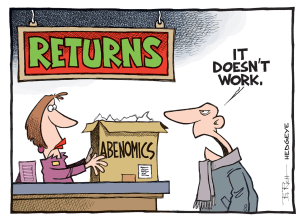TOKYO — The next blow to the collective Japanese psyche will be falling behind Germany to become the fourth-biggest economy. Yet, 12 years on, Tokyo is still grappling with having watched China surpass it in gross domestic product terms.
It was in 2010 and 2011 that banner headlines proclaimed the changing of the guard, when the economic student amassed greater power than the teacher. China, like South Korea, Taiwan, Thailand and other Asian “tigers,” cribbed from parts of Japan’s development model.
Why, then, is Japan’s fiercely proud political establishment making it so easy for China to continue to throttle forward?
Many Japan pundits disagree with the terms of this debate vehemently. The force is strong with the conventional wisdom, which is that GDP matters far less than per capita income – a metric on which Japan blows the doors off China.
And, clearly, Chinese leader Xi Jinping has shot his economy in the foot enough times to slow progress. From disruptive crackdowns on tech to draconian Covid lockdowns, Xi has generated more headwinds than tailwinds since 2020.
Yet many global investors and academics can’t help but wonder what, oh what, Japanese Prime Minister Fumio Kishida’s Liberal Democratic Party is up to as Asia’s economic clock speeds up and China raises its game.
In 2013, the LDP returned to power with a bold plan to get Japan’s economic groove back. At the time, Prime Minister Shinzo Abe made unveiled references to reminding China whose continent Asia is.
Sadly, his pledges – to reduce bureaucracy, increase innovation and productivity, liberalize labor markets, incentivize a startup boom, empower women, attract more foreign talent and give Shanghai a run for its money as Asia’s financial center – fell by the wayside.
Although Abe succeeded in strengthening corporate governance a bit, the dearth of reforms elsewhere stunted wage growth. Hopes for a virtuous cycle of fattened paychecks and a surge in domestic demand never materialized.
The reason is that Abe relied almost entirely on aggressive monetary easing to save the day. A 30% plunge in the yen in the years after 2013 generated record corporate profits. The trouble is, it deadened Japan’s competitive drive, too.
Weaker exchange rates took the onus off corporate chieftains to innovate, restructure and take risks. Politicians had no need to recalibrate engines toward domestic demand-led growth and away from a 1970s-like export-centric model.
Rather than delivering a shock to an atrophied economic system, Abenomics cemented its flaws. Japan effectively squandered the last 10 years during which it had a window of opportunity to narrow the gap with China. Hence the confusion among investors and academics about what Abe’s protégé, Kishida, is up to with regard to raising Japan’s own economic game.

Kishida started off well enough in October 2021. He rose to the premiership with his own ambitious “new capitalism” scheme to raise middle-class incomes. Yet like his mentor’s plan, Kishidanomics has been far more aspiration than actual retooling.
These two-plus years were fertile for Kishida to alter tax policy to encourage startup activity. In fact, he had an audacious plan to tap Japan’s US$1.6 trillion Government Pension Investment Fund to finance startups.
It’s the most creative idea the LDP has had to date to jumpstart the growth of Japan’s venture capital industry. Little has come of it, though. Kishida has prioritized fiscal stimulus and Bank of Japan easing over structural reform.
Nor has Kishida reinvigorated the unfinished Abe reforms. In the interim, China’s slowdown and the highest US bond yields in 17 years turned the tables on Japan’s post-pandemic recovery. The economy shrank 2.9% in the July-September period from the previous quarter.
There’s little in recent data to suggest the economy has gained any steam in the October-December quarter. This means Kishida will be even more preoccupied than usual, and less likely to resurrect the reform process.
This downshift also reduces the odds that BOJ will be “tapering” or normalizing rate policy anytime soon. If BOJ Governor Kazuo Ueda wasn’t comfortable pivoting away from quantitative easing in 2023, the odds may be even lower amid a deepening recession.
All this means Japan’s “opportunity cost” problem persists. When government after government chooses the easy way to boost growth, they’re choosing not to build economic muscle. This has been the trade-off the LDP accepted for decades, but especially these last 10 years.

If only Abe had made good use of his nearly eight years in office to remake the economy instead of relying on a weak yen, Japan might be booming. If only Abe’s successor Yoshihide Suga had used his 12 months in office to reanimate Japan’s animal spirits. Or if Kishida hadn’t let 26 months pass without putting any major upgrades on the scoreboard.
Now, with his approval rating at 17%, Kishida has negligible political capital to shake up the economy. As scandals engulf the LDP and opposition parties pounce, Kishida will be too busy in 2024 struggling to keep his job to do it.
As reform hopes fade, China has even freer reign over Asia’s future. For all China’s challenges, including a giant property crisis, the self-sabotage that Japanese politicians are inflicting on the economy plays right into Beijing’s hands.
Kishida is having to ramp up government spending to address the recession. This latest burst of borrowing is almost certain to pique the interest of credit rating companies like Moody’s Investors Service, which recently threatened to downgrade the US and China.
With a national debt more than twice GDP, Tokyo has limited fiscal space to act. This, in turn, will complicate Kishida’s plan to boost military spending by 50% over the next few years. Again, great news for Xi’s China as Tokyo’s security ambitions run into headwinds, too.
When investors and academics in Asia wonder why Japan thinks time is on its side, or what Kishida’s government is thinking, it’s a valid question. The longer Tokyo takes to answer it, the better it is for China’s ability to own the future.

